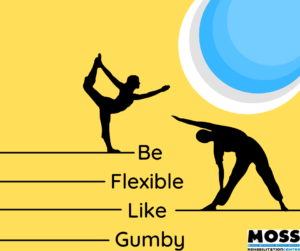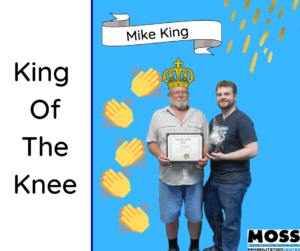In a previous blog post I have pointed out that knee pain affects over 25% of adults, and many of these people wind up having surgery to try and fix the problem. We have also discussed options to avoid surgery if possible HERE.
Today I want to cover some of the most frequently asked questions I get regarding knee pain. I am pulling back the curtain and opening the vault (Seinfeld reference), I hope this helps.
Q: How long is it going to take?
A: Ultimately it depends on you and your goal or goals.
AT MOSS Rehabilitation Center we created the MAGICAL 5 Phases of healing to give our patients the greatest chance for success. (CLICK HERE to read about The MAGICAL 5 Phases Of Healing)
At a bare minimum we like our patients to progress through phase 3. This helps you get out of pain, restore strength and mobility and return to some basic tasks at work and home.
For maximum benefit and greatest chance of success we recommend working through phases 4 – Maintenance and Injury Prevention and ultimately Phase 5 Performance Enhancement to help you not only survive but thrive.
We also look for fairly steady progress through the phases and make adjustments based on you and your goals. This is not a one size fits all program.
For example: you come to us shortly after stepping in a hole in your yard and twisting your knee. It is moderately painful with some mild swelling. We would examine the knee to see if you have torn any ligaments. If the ligaments are not torn and simply sprained I would expect the pain and inflammation to reduce within 2 weeks (as long as you are not out running or jumping on it) followed by another 2-4 weeks to make sure your motion and strength are back to normal.
If you are recovering from a ligament reconstruction or knee replacement then those time frames are extended significantly. Click here to learn what you need to know before having knee surgery.
Another often overlooked factor is your general health leading up to the knee issues. Many people are not as healthy as they think and having a minor sprain to the knee is really an eye opening experience.
Being overweight, non-active, and poor eating habits all factor into how long it takes to recover. You can read more about proper nutrition HERE.
Q: Should I use heat or ice on my knee?
A: If there is visible, local swelling and you have recently injured your knee (in the last 3 days/72 hours) then I advise my patients to elevate the knee above the level of the heart and apply ice packs.
Think of the R.I.C.E principle. Rest, Ice, Compression and Elevation.
After the first 72 hours I typically switch to a low grade heating pad prior to exercise or movement to simply loosen up the joint. At this point you can ice after the activity or exercise.
Unless you are recovering from a surgery most of my patients stop icing the knee after exercise as it makes them feel stiff after they worked so hard to get the knee moving.
Heat also improves the blood flow which brings with it oxygen to help with tissue healing.
Q: What are the best exercises for knee pain?
A: The best exercises are the ones your physical therapist has prescribed specifically for you and your condition. However if you don’t have a physical therapist or are looking for something to try before you can get in then I recommend the following:
- Working your hips is a must. Click HERE to learn the 2 Things You Must Do To Fix Your Knee, hint, it is not what you think.
Ultimately you need to strengthen your glute muscles (maximus and medius). A simple way to do this is to lay on your side and lift your top leg up about 6-12 inches. Hold for 3-5 seconds and then repeat. See those Hips Don’t Lie for more information.
- Work on your knee mobility: this can be tricky and let pain be your guide but laying on your back and sliding your foot up and down to bend the knee is a simple way to get started. To see how close your motion is to “normal” bend the knee that is not hurting as a comparison. If you are having trouble you can use a belt or a rope wrapped around your foot to help with the bending process.
- Work on your ankle mobility and strength. Similar to working your knee, the ankle is important for adapting to the local terrain and keeping you upright. Stiffness or weakness in the ankles can lead to balance problems and falls. A simple “calf stretch” exercise along with some “heel raises” for strength is a good way to start.
Q: How often should I do the exercises?
A: Again this depends on the Phase of your recovery. If you are in Phase I and II then generally we recommend patients perform some light exercises several times a day. As they progress into Phases III-V then 3-5 times a week is sufficient.
Q: How Do I know If Physical Therapy Is Right For Me? Isn’t all physical therapy the same?
A: No, actually physical therapists have different training aside from the basics they receive when in school. Just as a physician will specialize in orthopedics or cardiology, physical therapists can also do the same.
You want to find one who is knowledgeable and experienced in the condition you are having and has a track record of getting great results. Ask you friends, they often know.
The truth is you won’t know if physical therapy is right for you until you try. (For more tips request my free report How To Choose The Right Physical Therapist) by calling 817-220-MOSS (6677)
This is one of the reasons we offer a FREE “What’s wrong with my knee” Discovery Visit
During the check up we will determine:
1. The cause of your knee pain.
2. If you need an MRI or x-ray (Luckily, usually not.)
3. What successful and natural treatment looks like for you?
4. How to avoid the biggest mistake people with knee pain make.
Whether your knee pain is new or has been bothering you for years, give us a call 817-220-MOSS (6677).
We’ve helped athletes, weekend warriors, and couch potatoes all improve their knees and get back to moving better without pain, and we would love to help you too.
At MOSS Rehabilitation Center we make it easy for you to get started. We even have a simple 3 step process.
1. Schedule a FREE NO Obligation Discovery Visit with one of our experts. During this visit, you will talk with one of our friendly experts about your issues. This is a safe and confidential visit, you can trust that your safety and privacy is important to us. We are taking extra measures to ensure that you remain safe during this pandemic.
2. Receive a Customized (Individualized) Treatment Plan. Based on your free discovery visit, we will put together a custom, unique to you plan that will address all of your nagging pains and issues. The goal is to get you back to your healthy self as soon as possible while also addressing your issues for the long term.
3. Get Your Life Back and Do What You Love. The best result for us is a patient who tells us they can finally do what they love without the constant pain, stress, or issue they were facing. Together we can get you back to living life without worry.
So what do the most successful people do when they have knee pain? They address their problem.
I call it the 3 D’s Principle to handling any problem in life: 1. Don’t Ignore it, 2. Don’t Mask It, 3. Do Something About It.
NEXT ACTION: If you are really serious about your knee health start by calling 817-220-6677 today to schedule your FREE NO OBLIGATION Discovery Visit.
To your health,
Dr. Robert Moss PT, ScD, OCS. FAAOMPT
The author, Dr. Robert Moss PT, ScD is the owner of MOSS Rehabilitation Center in Springtown, TX. He is happy to help you with your knee pain and problems either by phone 817-220-MOSS (6677) or email robert@springtownphysicalthearpy.com.


